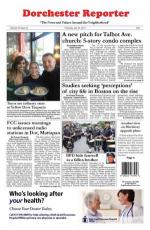December 16, 2010
Boston Public Library officials and developers of the former St. Kevin’s school property are pushing ahead with a tentative plan to relocate the Uphams Corner branch library within one of their new residential buildings planned for the site.
The proposed library would take up 6,000 square feet and the majority of the first floor of a new building planned for the corner of Columbia Road and Davern Avenue.
The library is currently located on two floors at 500 Columbia Rd., an old municipal building that also houses a health center.
Three organizations have partnered up in the development of the former St. Kevin’s school, which closed in 2008: the St. Mary’s Women and Children’s Center, the Holy Family Parish, and a nonprofit real estate developer with ties to the Boston archdiocese’s Planning Office of Urban Affairs. The partnership, which is seeking to build 80 units of housing in three buildings spread out over 2.43 acres, is also attempting to buy a city-owned lot, totaling 7,300 square feet, that sits on the same block next to the property. They were recently the only bidders for the city property.
In documents submitted to the city’s planning and development agency, the Boston Redevelopment Authority, which must sign off on the project, the developers called the present library “unsafe, not visible and not accessible to the general public.”
Developers said this week that by “unsafe,” they meant the location is poorly laid out, making it easy to lose sight of children. The basement of the current children’s section was converted from a swimming pool and has a tendency to leak during storms.
Developers also said that BPL President Amy Ryan had called the Uphams Corner branch the most “substandard” branch in the 26-library system.
Library officials disputed the characterizations that it was unsafe and substandard. “There are many people of all ages who continue to use the Uphams Corner Library and the building is regularly accessed by the public,” Gina Perille, a BPL spokeswoman, wrote in an e-mail. “People are using the computers, using the wireless network, checking out books, reading magazines, and more. Young people continue to use the library, too, for programs, and homework assistance.”
But, she said in a separate statement, the project to relocate the library has “tremendous potential,” from the Boston Public Library’s perspective. “The proposal and discussion around the St. Kevin’s property is an example of the kind of first step that has to be taken in creating a capital request,” she said.
Marti Glynn, chairwoman of a recently reactivated support group for the Uphams Corner branch, called the building “hopelessly outdated” and noted it was not handicapped accessible.
The move to relocate the library comes as the system struggles with cuts. Earlier this year, neighborhood residents in Dorchester, South Boston, East Boston, and Brighton were able to beat back an attempt to close branches in their neighborhoods. But funding gaps remain, and library officials have pledged to keep the branches open, contingent on the system receiving an influx of funds from state lawmakers.
The developers of the St. Kevin’s site say the decision to relocate is up to the Boston Public Library’s board of trustees, though that may not come until mid-2011. They are hoping to receive approval from the BRA by next year and begin construction by late 2011 or early 2012.
“It is not certain,” Lisa Alberghini, president of the Planning Office of Urban Affairs, said of the relocation at a BRA-hosted community meeting on Monday night.
“If the library plan does not prove feasible, the developer would maintain that a 1,000 sf community room be included in the new building, which would be open to the community for meetings, events, educational opportunities, etc.,” developers wrote in their documents to the BRA. They had initially planned to include retail space as part of the project, but pulled back once they realized the neighborhood has a 25 percent vacancy rate for such space, they said.
Separately, a transportation study, included in documents provided to the BRA and available for viewing at the Uphams Corner library, said that the project will have a “negligible impact on area roadways due to its transit orientated and predominately residential nature.”



